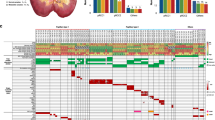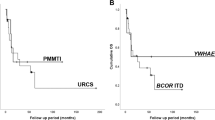Abstract
Clear cell sarcoma of the kidney (CCSK) is one of the major pediatric renal neoplasms, but its associated genetic abnormalities are largely unknown. We identified internal tandem duplications in the BCOR gene (BCL6 corepressor) affecting the C terminus in 100% (20/20) of CCSK tumors but in none (0/193) of the other pediatric renal tumors. CCSK tumors expressed only an aberrant BCOR allele, indicating a close correlation between BCOR aberration and CCSK tumorigenesis.
This is a preview of subscription content, access via your institution
Access options
Subscribe to this journal
Receive 12 print issues and online access
$209.00 per year
only $17.42 per issue
Buy this article
- Purchase on Springer Link
- Instant access to full article PDF
Prices may be subject to local taxes which are calculated during checkout

Similar content being viewed by others
References
Argani, P. et al. Am. J. Surg. Pathol. 24, 4–18 (2000).
Oue, T. et al. Pediatr. Surg. Int. 25, 923–929 (2009).
Furtwängler, R. et al. Eur. J. Cancer 49, 3497–3506 (2013).
Seibel, N.L. et al. J. Clin. Oncol. 22, 468–473 (2004).
Tournade, M.F. et al. J. Clin. Oncol. 19, 488–500 (2001).
Perlman, E.J. Pediatr. Dev. Pathol. 8, 320–338 (2005).
O'Meara, E. et al. J. Pathol. 227, 72–80 (2012).
Ueno, H. et al. PLoS ONE 8, e62233 (2013).
Viré, E. et al. Nature 439, 871–874 (2006).
Fuks, F., Hurd, P.J., Deplus, R. & Kouzarides, T. Nucleic Acids Res. 31, 2305–2312 (2003).
Gadd, S., Sredni, S.T., Huang, C.C. & Perlman, E.J. Lab. Invest. 90, 724–738 (2010).
Junco, S.E. et al. Structure 21, 665–671 (2013).
Gearhart, M.D., Corcoran, C.M., Wamstad, J.A. & Bardwell, V.J. Mol. Cell. Biol. 26, 6880–6889 (2006).
Blackledge, N.P. et al. Cell 157, 1445–1459 (2014).
Pugh, T.J. et al. Nature 488, 106–110 (2012).
Zhang, J. et al. Nature 481, 329–334 (2012).
Shern, J.F. et al. Cancer Discov. 4, 216–231 (2014).
Grossmann, V. et al. Blood 118, 6153–6163 (2011).
Pierron, G. et al. Nat. Genet. 44, 461–466 (2012).
Rothermel, B. J. Biol. Chem. 275, 8719–8725 (2000).
Acknowledgements
This work was supported in part by the Grant from the National Center for Child Health and Development (24-4, 26-20), grants from the Program for Promotion of Fundamental Studies in Health Sciences of the National Institute of Biomedical Innovation (NIBIO; 10-41, 10-42, 10-43, 10-44, 10-45), and a research program of the Project for Development of Innovative Research on Cancer Therapeutics (11035153) and Tailor-Made Medical Treatment Program (BioBankJapan), Ministry of Education, Culture, Sports, Science and Technology of Japan. The funders had no role in study design, data collection and analysis, decision to publish or preparation of the manuscript.
Author information
Authors and Affiliations
Contributions
H.U.-Y. and H.O. designed the study. H.U.-Y., H.O., K.N. and S.A. performed the experiments. H.O. and J.H. conducted a pathological review. T.K. and M.F. provided patient materials. H.U.-Y., H.O. and N.K. wrote the manuscript.
Corresponding author
Ethics declarations
Competing interests
The authors declare no competing financial interests.
Integrated supplementary information
Supplementary Figure 1 Histopathological features of CCSK.
Hematoxylin-eosin staining shows typical histopathological features of CCSK. Scale bar, 100 µm.
Supplementary Figure 2 Genomic sequence alignment of wild-type and aberrant BCOR.
Genomic sequences corresponding to 5,068–5,268 nt of BCOR (CCDS48093.1) are aligned.
Supplementary Figure 3 BCOR expression in pediatric renal tumors and kidney.
(a) Quantitative RT-PCR of BCOR. The beeswarm and box plots present relative values of BCOR expression normalized with ACTB. (b) Two P values were calculated by pairwise comparisons using the Wilcoxon rank-sum test with the methods of Bonferroni and FDR.
Supplementary Figure 4 Western blot detection of BCOR protein expression in kidney, CCSK and other pediatric renal tumors.
Top, BCOR (arrowhead, full length). Bottom, lamin A/C (large fragment, lamin A; small fragment, lamin C). M, pre-stained protein marker (Broad Range, Nacalai Tesque); 1, HEK293; 2, Kidney6; 3, Kidney7; 4, CCSK8; 5, CCSK13; 6, RTK4; 7, RTK7; 8, CMN5; 9, CMN6; 10, Wilms43; 11, Wilms53.
Supplementary Figure 5 Immunohistochemical staining of BCOR in CCSK and non-CCSK tissues.
Scale bar, 100 µm.
Supplementary Figure 6 Immunoblotting and soft agar colony formation assay of HEK293 cells expressing exogenous BCORs.
(a) Detection of endogenous and exogenous BCOR proteins in HEK293 cells. Top, BCOR (arrowhead, full length). Bottom, lamin A/C (large fragment, lamin A; small fragment, lamin C). Lane 1, empty vector; lane 2, wild-type BCOR; lane 3, mutant 1 BCOR; lane 4, mutant 2 BCOR. (b) Soft agar colony formation assay with HEK293 cells expressing exogenous BCOR proteins. Error bars, s.e.m. *P < 0.05 (Welch’s t test, two-sided). (c) Images are the magnified center part (1.5 mm2) of wells.
Supplementary information
Supplementary Text and Figures
Supplementary Figures 1–6 and Supplementary Tables 1 and 2. (PDF 915 kb)
Rights and permissions
About this article
Cite this article
Ueno-Yokohata, H., Okita, H., Nakasato, K. et al. Consistent in-frame internal tandem duplications of BCOR characterize clear cell sarcoma of the kidney. Nat Genet 47, 861–863 (2015). https://doi.org/10.1038/ng.3338
Received:
Accepted:
Published:
Issue Date:
DOI: https://doi.org/10.1038/ng.3338
This article is cited by
-
High-grade neuroepithelial tumor with EP300::BCOR fusion and negative BCOR immunohistochemical expression: a case report
Brain Tumor Pathology (2023)
-
Establishment of multiplex RT-PCR to detect fusion genes for the diagnosis of Ewing sarcoma
Diagnostic Pathology (2021)
-
Integrated diagnosis based on transcriptome analysis in suspected pediatric sarcomas
npj Genomic Medicine (2021)
-
Wilms tumour
Nature Reviews Disease Primers (2021)
-
Targeted RNA expression profiling identifies high-grade endometrial stromal sarcoma as a clinically relevant molecular subtype of uterine sarcoma
Modern Pathology (2021)



